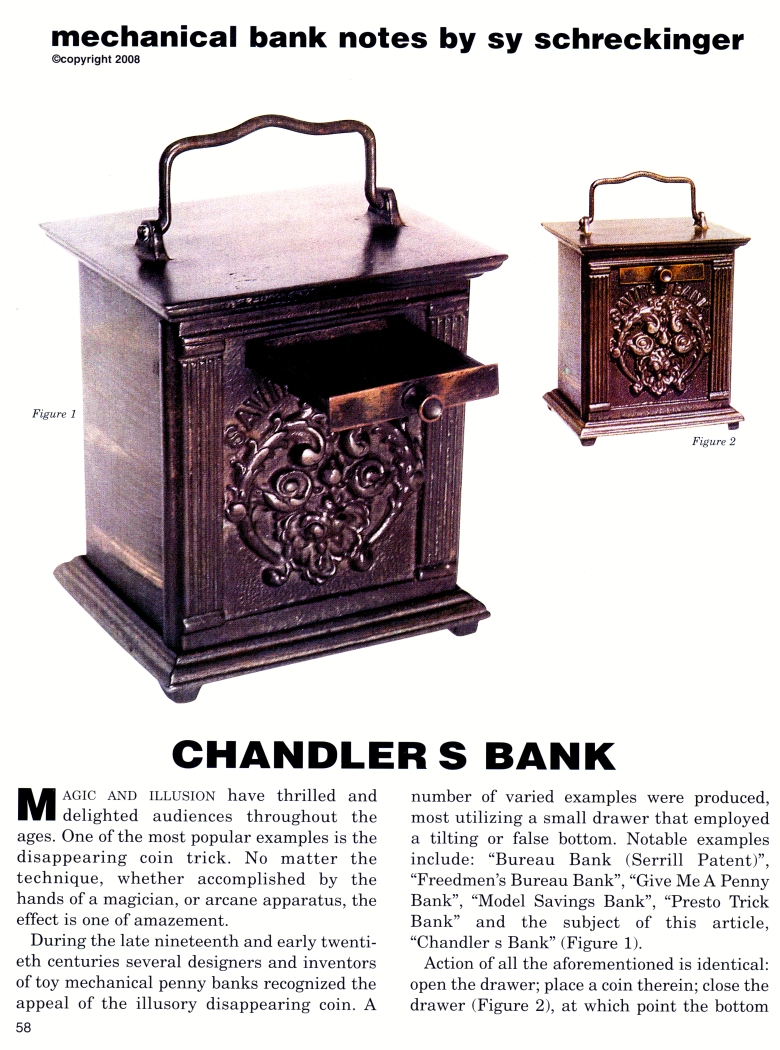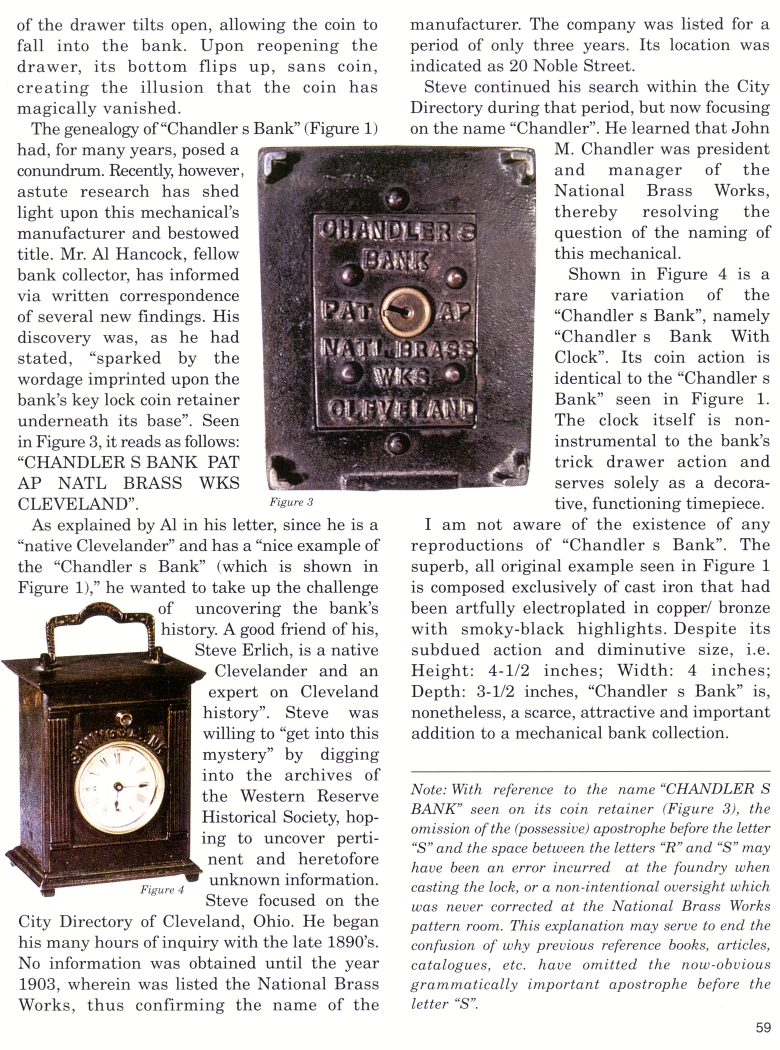|
Chandler
s Bank
by Sy Schreckinger – ANTIQUE TOY WORLD Magazine – June, 2008
Magic and illusion have thrilled and delighted
audiences throughout the ages. One of the most popular examples is the
disappearing coin trick. No matter the technique, whether accomplished by
the hands of a magician, or arcane apparatus, the effect is one of
amazement.
During the late nineteenth and early twentieth centuries several
designers and inventors of toy mechanical penny banks recognized the
appeal of the illusory disappearing coin. A number of varied examples were
produced, most utilizing a small drawer that employed a tilting or false
bottom. Notable examples include: "Bureau Bank (Serrill Patent)",
"Freedmen's Bureau Bank", "Give Me A Penny Bank", "Model Savings Bank",
"Presto Trick Bank" and the subject of this article, "Chandler s Bank"
(Figure 1).
Action of all the aforementioned is identical: open the drawer; place
a coin therein; close the drawer (Figure 2), at which point the bottom of
the drawer tilts open, allowing the coin to fall into the bank. Upon
reopening the drawer, its bottom flips up, sans coin, creating the
illusion that the coin has magically vanished.
The genealogy of "Chandler s Bank" (Figure 1) had, for many years,
posed a conundrum. Recently, however, astute research has shed light upon
this mechanical's manufacturer and bestowed title. Mr. Al Hancock, fellow
bank collector, has informed via written correspondence of several new
findings. His discovery was, as he had stated, "sparked by the wordage
imprinted upon the bank's key lock coin retainer underneath its base".
Seen in Figure 3, it reads as follows: "CHANDLER S BANK PAT AP NATL BRASS
WKS CLEVELAND".
As explained by Al in his letter, since he is "native Clevelander"
and has a "nice example of the "Chandler s Bank" (which is shown in
Figure 1)," he wanted to take up the challenge of uncovering the bank's
history. A good friend of his, Steve Erlich, is a native Clevelander and
an expert on Cleveland history". Steve was willing to "get into this
mystery" by digging into the archives of the Western Reserve Historical
Society, hoping to uncover pertinent and heretofore unknown information.
Steve focused on the City Directory of Cleveland, Ohio. He began his many
hours of inquiry with the late 1890's. No information was obtained until
the year 1903, wherein was listed the National Brass Works, thus
confirming the name of the manufacturer. The company was listed for a
period of only three years. Its location was indicated as 20 Noble Street.
Steve continued his search within the City Directory during that
period, but now focusing on the name "Chandler". He learned that John M.
Chandler was president and manager of the National Brass Works, thereby
resolving the question of the naming of this mechanical.
Shown in Figure 4 is a rare variation of the "Chandler s Bank",
namely "Chandler s Bank With Clock". Its coin action is identical to the
"Chandler s Bank" seen in Figure 1. The clock itself is non-instrumental
to the bank's trick drawer action and serves solely as a decorative,
functioning timepiece.
I am not aware of the existence of any reproductions of "Chandler s
Bank". The superb, all original example seen in Figure 1 is composed
exclusively of cast iron that had been artfully electroplated in copper/
bronze with smoky-black highlights. Despite its subdued action and
diminutive size, i.e. Height: 4-1/2 inches; Width: 4 inches; Depth: 3-1/2
inches, "Chandler s Bank" is, nonetheless, a scarce, attractive and
important addition to a mechanical bank collection.
Note: With reference to the name "CHANDLER S BANK" seen on its coin
retainer (Figure 3), the omission of the (possessive) apostrophe before
the letter "S" and the space between the letters "R" and "S" may have been
an error incurred at the foundry when casting the lock, or a
non-intentional oversight which was never corrected at the National Brass
Works pattern room. This explanation may serve to end the confusion of why
previous reference books, articles, catalogues, etc. have omitted the
now-obvious grammatically important apostrophe before the letter "S".
|


